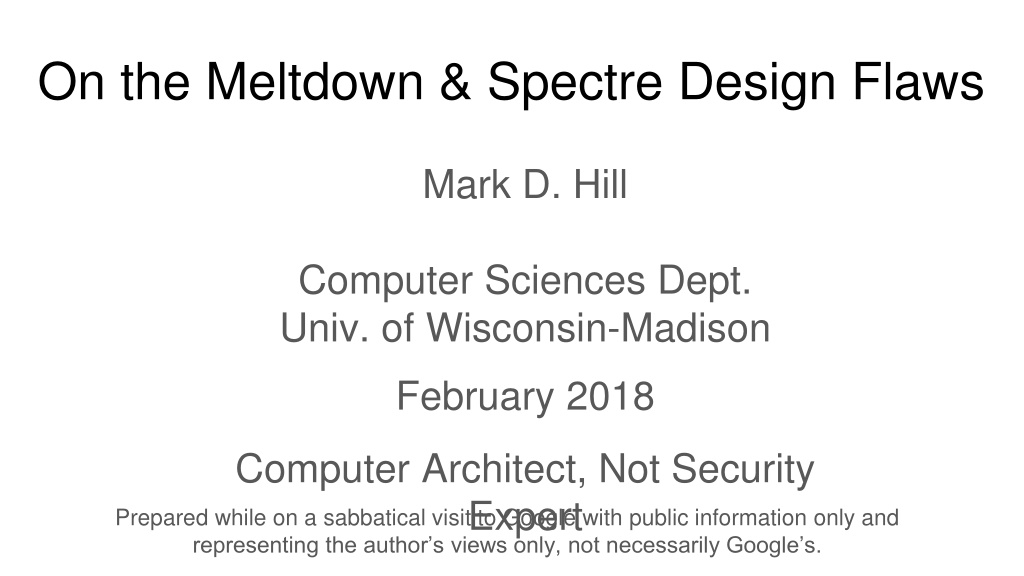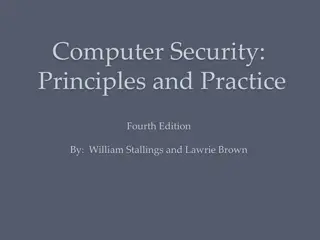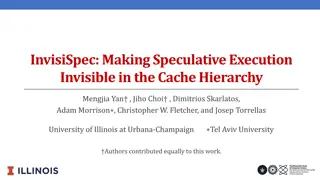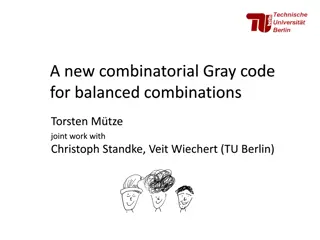Insights into Meltdown and Spectre Design Flaws
Delve into the flaws of Meltdown and Spectre, where a computer can leak protected information via timing, despite being correct by Architecture 1.0. Explore the implications and necessary fixes to enhance information security in computer architecture and micro-architecture.
Download Presentation

Please find below an Image/Link to download the presentation.
The content on the website is provided AS IS for your information and personal use only. It may not be sold, licensed, or shared on other websites without obtaining consent from the author.If you encounter any issues during the download, it is possible that the publisher has removed the file from their server.
You are allowed to download the files provided on this website for personal or commercial use, subject to the condition that they are used lawfully. All files are the property of their respective owners.
The content on the website is provided AS IS for your information and personal use only. It may not be sold, licensed, or shared on other websites without obtaining consent from the author.
E N D
Presentation Transcript
On the Meltdown & Spectre Design Flaws Mark D. Hill Computer Sciences Dept. Univ. of Wisconsin-Madison February 2018 Computer Architect, Not Security Expert representing the author s views only, not necessarily Google s. Prepared while on a sabbatical visit to Google with public information only and
Executive Summary Architecture 1.0: the timing-independent functional behavior of a computer Micro-architecture: the implementation techniques to improve performance Question: What if a computer that is completely correct by Architecture 1.0 can be made to leak protected information via timing, a.k.a., Micro-Architecture? Meltdown leaks kernel memory, but software & hardware fixes exist Spectre leaks memory outside of bounds checks or sandboxes, and is scary Implication: The definition of Architecture 1.0 is inadequate to protect information
Outline Computer Architecture & Micro-Architecture Background Timing Side-Channel Attack Meltdown Spectre Wrap-Up
Computer Architecture 0.0 -- Pre-1964 Each Computer was New Implemented machine (has mass) hardware Instructions for hardware (no mass) software Software Lagged Hardware Each new machine design was different Software needed to be rewritten in assembly/machine language Unimaginable today Going forward: Need to separate HW interface from implementation
Computer Architecture 1.0 -- Born 1964 IBM System 360 defined an instruction set architecture branch (R1 >= bound) goto error load R2 memory[train+R1] and R3 R2 && 0xffff load R4 memory[save+SIZE+R3] Stable interface across a family of implementations Software did NOT have to be rewritten Architecture 1.0: the timing-independent functional behavior of a computer Micro-architecture: implementation techniques that change timing to go fast Note: The code is not IBM 360 assembly, but is the example used later.
Micro-architecture Harvested Moores Law Bounty For decades, every ~2 years: 2x transistors, 1.4x faster & 1x chip power possible; 2300 transistors for Intel 4004 millions per core & billions for caches (Micro-)architects took this ever doubling budget to make each processor core execute > 100x than what it would otherwise. Key techniques w/ tutorial next: Instruction Speculation Hardware Caching Hidden by Architecture 1.0: timing-independent functional behavior unchanged
Instruction Speculation Tutorial Many steps (cycles) to execute one instruction; time flows left to right add load Go Faster: Pipelining, branch prediction, & instruction speculation add load Predict direction: target or fall thru branch and Speculate! store Speculate more! Speculation correct: Commit architectural changes of and (register) & store (memory) go fast! Mis-speculate: Abort architectural changes (registers, memory); go in other branch direction
Hardware Caching Tutorial Main Memory (DRAM) 1000x too slow Add Hardware Cache(s): small, transparent hardware memory Like a software cache: speculate near-term reuse (locality) is common Like a hash table: an item (block or line) can go in one or few slots E.g., 4-entry cache w/ slot picked with address (key) modulo 4 0 1 2 3 0 1 2 3 0 1 2 3 0 1 2 3 0 1 2 3 12? Miss Insert 12 07? Miss Insert 07 12? HIT! No 16? Miss Note 12 victimized early due to alias -- -- -- -- 12 -- -- -- 12 -- -- 07 12 -- -- 07 16 -- -- 07 Victim 12 Insert 16 changes
Micro-architecture Harvested Moores Law Bounty For decades, every ~2 years: 2x transistors, 1.4x faster & 1x chip power possible; 2300 transistors for Intel 4004 millions per core & billions for caches (Micro-)architects took this ever doubling budget to make each processor core execute > 100x what it would otherwise branch (R1 >= bound) goto error ; Speculate branch not taken load R2 memory[train+R1] ; Speculate load & speculate cache hit and R3 R2 && 0xffff ; Speculate AND load R4 memory[save+SIZE+R3] ; Speculate load & speculate cache hit Hidden by Architecture 1.0: timing-independent functional behavior unchanged
Whither Computer Architecture 1.0? Architecture 1.0: timing-independent functional behavior Question: What if a computer that is completely correct by Architecture 1.0 can be made to leak protected information via timing, a.k.a., micro-architecture? Implication: The definition of Architecture 1.0 is inadequate to protect information This is what Meltdown and Spectre do. Let's see why and explore implications.
Side-Channel Attack: SAVE Secret in Micro-Arch 1. Prime micro-architectural state a. Repeatedly access array train[]to train branch predictor to expect access < bound b. Access all of array save[]to put it completely in a cache of size SIZE 2. Coerce processor into speculatively executing instructions that will be nullified to (a) find a secret & (b) save it in micro-architecture branch (R1 >= bound) goto error ; Speculate not taken even if R1 >= bound load R2 memory[train+R1] ; Speculate to find SECRET outside of train[] and R3 R2 && 0xffff ; Speculate to convert SECRET bits into index load R4 memory[save+SIZE+R3] ; Speculate to save SECRET by victimizing memory[save+R3] since it aliases in cache with new access memory[save+SIZE+R3] 3. HW detects mis-speculation Undoes architectural changes Leaves cache (micro-architecture) changes (correct by Architecture 1.0)
Side-Channel Attack: RECALL Secret from Micro-Arch 4: Probe time to access each element of save[]--micro-architectural property; If accessing save[foo] slow due to cache miss, then SECRET is foo. A leak! 5: Repeat many times to obtain secret information at some bandwidth. (More shifting/masking needed to get all SECRET bits victimizing 64B cache lines) Well-known in 1983/85 DoD Orange Book Covert timing channels include all vehicles that would allow one process to signal information to another process by modulating its own use of system resources in such a way that the change in response time observed by the second process would provide information. --TRUSTED COMPUTER SYSTEM EVALUATION CRITERIA With roots back to 1974 TENEX password attack But seemed fanciful Spy vs. Spy, Mad Magazine, 1960
Meltdown (https://meltdownattack.com/meltdown.pdf) Can leak the contents of kernel memory at up to 500KB/s TRAP!! (not branch) Under mis- speculation
Meltdown & Hardware Demonstrated for many Intel x86-64 cores; NOT demonstrated for AMD Key: When to suppress load with protection violation (user load to kernel memory) EARLY: AMD appears to suppress early, e.g., at TLB access LATE: Intel appears to suppress at end after micro-arch state changes My SWAG (Scientific Wild A** Guess) Why Both are correct by Architecture 1.0 Performance shouldn t matter as this case is supposed to be rare Do what s easiest & have luck that is good (AMD) or bad (Intel)
Meltdown & Software Bad: Meltdown operates with bug-free OS software (by Architecture 1.0) Good: Major commercial OSs patched for Meltdown ~January 2018 Idea: Don t map (much) of protected kernel address space in user process Offending load now fails address translation & does nothing Patches quickly derived from KAISER developed for side-channel attacks of Kernel Address Space Layout Randomization (KASLR) Performance impact 0-30% syscall frequency & core model. Future hardware can fix Meltdown (like AMD) so maybe we dodged a bullet
Spectre (https://spectreattack.com/spectre.pdf) Classic side-channel attack w/ deep micro-arch info 1. Attacker primes micro-architecture E.g, branch predictor or branch target buffer for saving secret E.g., cache for recalling secret 2: Victim loads secret under mis-speculation Load should NOT trap (unlike Meltdown) Still inappropriate if managed language or sandbox 3: Victim saves secret in micro-arch state, e.g., cache 4: Attacker recalls secret from micro-arch state; 4: repeat.
Spectre Applicability (Paper Sections 4, 5, & 6) 4. Exploit branch mis-prediction to let Javascript steal from Chrome browser Demonstrated Intel Haswell/Skylake, AMD Ryzen, & several ARM cores Many other existing designs vulnerable 5. branch target buffer to obtain information from different hyper-thread on same core Used indirect branches & return-oriented programming to mis-train 6. functional unit occupancy, but what about unknown timing channels? Many other known timing-channel exist, e.g., register file contention,
Spectre Mitigation (Section 7) Branch prediction SW: Suppress branch prediction when important with mfence, etc. Not defined to work but appears to work--at a performance cost HW could auto-magically suppress branch prediction when appropriate (???) Branch Target Buffer SW: Not clear. Disable hyper-threading, etc.? HW: Make micro-architecture state private to thread (not core or processor) More generally: Hard to mitigate threats NOT YET DEFINED.
Need Computer Architecture 2.0? With Meltdown & Spectre, Architecture 1.0 is inadequate to protect information Augment Architecture 1.0 with Architecture 2.0 specification of (Abstraction of) time-visible micro-architecture? Bandwidth of known (unknown?) timing channels? Enforced limits on user software behavior? (c.f., KAISER) Change Microarchitecture to mitigate timing channel bandwidth Suppress some speculation Undo most changes on mis-speculation Can this be (formally) solved or must it be managed like crime?
Need Computer Architecture 2.0? More generally, can we reduce our dependence on SPECULATION? Accelerators!! GPU, DSP, IPU, TPU, ... [Hennessy & Patterson 2018 Taxonomy] Dedicated Memories More ALUs Easy Parallelism Lower precision data Domain Specific Language Yavits et al. MultiAmdahl, 2017 Speculation NOT a first- order feature! In 2005, Arvind said Speculation (w/ von Neumann model) killed Dataflow After 2018, Dataflow-like Renaissance w/ Sea of Accelerators?
Executive Summary Architecture 1.0: the timing-independent functional behavior of a computer Micro-architecture: the implementation techniques to improve performance Question: What if a computer that is completely correct by Architecture 1.0 can be made to leak protected information via timing, a.k.a., Micro-Architecture? Meltdown leaks kernel memory, but software & hardware fixes exist Spectre leaks memory outside of bounds checks or sandboxes, and is scary Implication: The definition of Architecture 1.0 is inadequate to protect information
Some References New York Times: https://www.nytimes.com/2018/01/03/business/computer-flaws.html Meltdown paper: https://meltdownattack.com/meltdown.pdf Spectre paper: https://spectreattack.com/spectre.pdf A blog separating the two bugs: https://danielmiessler.com/blog/simple-explanation-difference-meltdown-spectre/ Google Blog: https://security.googleblog.com/2018/01/todays-cpu-vulnerability-what-you-need.html and https://googleprojectzero.blogspot.com/2018/01/reading-privileged-memory-with-side.html Industry News Sources: https://arstechnica.com/gadgets/2018/01/whats-behind-the-intel-design-flaw-forcing-numerous- patches/ and https://www.theregister.co.uk/2018/01/02/intel_cpu_design_flaw/
Spectre Code Example Listing 2: Exploiting Speculative Execution via JavaScript 1 if (index < simpleByteArray.length) { 2 index = simpleByteArray[index | 0]; 3 index = (((index * TABLE1_STRIDE)|0) & (TABLE1_BYTES-1))|0; 4 localJunk ^= probeTable[index|0]|0; 5} Listing 3: Disassembly of Speculative Execution in Listing 2 JavaScript 1 cmpl r15,[rbp-0xe0] ; Compare index (r15) against simpleByteArray.length 2 jnc 0x24dd099bb870 ; If index >= length, branch to instruction after move below 3 REX.W leaq rsi,[r12+rdx*1] ; Set rsi=r12+rdx=addr of first byte in simpleByteArray 4 movzxbl rsi,[rsi+r15*1] ; Read byte from address rsi+r15 (= base address+index) 5 shll rsi, 12 ; Multiply rsi by 4096 by shifting left 12 bits}\%\ 6 andl rsi,0x1ffffff ; AND reassures JIT that next operation is in-bounds 7 movzxbl rsi,[rsi+r8*1] ; Read from probeTable 8 xorl rsi,rdi ; XOR the read result onto localJunk 9 REX.W movq rdi,rsi ; Copy localJunk into rdi
Meltdown v. Spectre Miessler Blog (https://danielmiessler.com/blog/simple-explanation-difference-meltdown-spectre/ )























